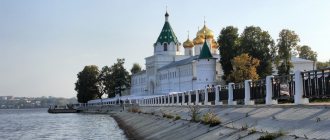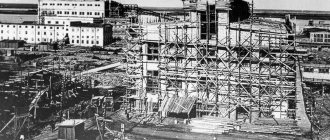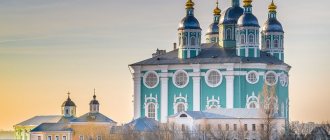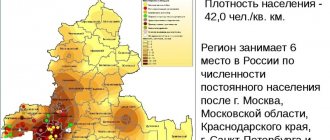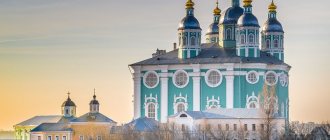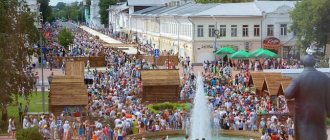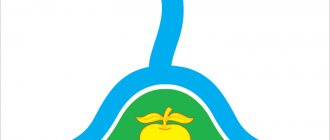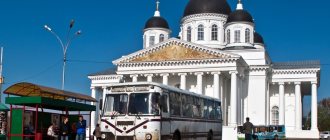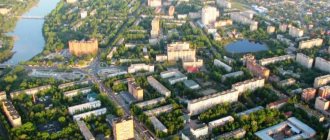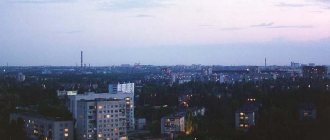| City of Novomichurinsk A country
Show/hide cards | |||||||||||||||||||||||||||||
| Novomichurinsk Moscow |
| Ryazan Pronsk Novomichurinsk |
| Pronsk Novomichurinsk |
K: Settlements founded in 1968
Novomichurinsk
- a city in the Pronsky district of the Ryazan region. Located in the north of the Oka-Don Plain, on the right bank of the Pronya River (a tributary of the Oka), 20 km from the Birkino railway station, 85 km south of Ryazan. It occupies an area of 26 km² at 120 meters above sea level.
Story
The city was founded on May 24, 1968 as a settlement for the builders of the Ryazan State District Power Plant. The city received its modern name in honor of the breeder I.V. Michurin (1855-1935), who was born near Novomichurinsk, in the former Vershina estate (now the village of Michurovka), where he began his work on plant growing.
Initially, it was a small village consisting of prefabricated wooden houses and construction trailers, divided into small streets and neighborhoods. The first residential trailer was delivered in April 1968. The mobile houses housed a bathhouse, a kindergarten, a dining room, a store, a club, and a library.
In May 1968, builders began digging a foundation pit for the first five-story building. By the end of 1968, the city had 200 temporary houses, had its own water supply, a full-fledged boiler room, a dining room, a bathhouse, a store, a concrete plant, and a new club with a library. In 1969, construction of the Pronsk-GRES highway and a railway line began.
In 1973, the Ryazan State District Power Plant produced its first current, and in March 1986, State District Power Plant-24 was put into operation with an installed capacity of 310 MW.
By the decision of the Ryazan Regional Council of Workers' Deputies on July 4, 1970, Novomichurinsk received the status of a workers' village. By decree of the Presidium of the Supreme Soviet of the RSFSR in 1981, Novomichurinsk received the status of a city.
Kasimov - the number is inexorably decreasing
Second place in the ranking is occupied by small Kasimov, where 17 times fewer people live. It is also one of the oldest cities in Russia, founded in 1152. It stands on the banks of the Oka River, 262 km from Moscow and 165 km from the regional capital. In the mid-19th century, there were about 10,000 residents, and during the period of Soviet power, the figure tripled, reaching the maximum value for the entire period of the settlement’s existence of 37,900 people in 1992.
Then a steady decline began, which continues to this day, and at a fairly serious pace for such a small city. At the beginning of 2022, the population was 30,696 people, which means it has fallen by almost 20% over 27 years. The reason is not only the demographic crisis, but also the migration of young people to larger Ryazan and Moscow. Today, industrial enterprises continue to operate in the city, the largest of which is the Prioksky Non-Ferrous Metals Plant. There are also many historical monuments here, but income from tourism does not have a major economic impact.
Notes
- ↑ 12
www.gks.ru/free_doc/doc_2016/bul_dr/mun_obr2016.rar Population of the Russian Federation by municipalities as of January 1, 2016 - [demoscope.ru/weekly/ssp/rus79_reg2.php All-Union Population Census of 1979 The size of the urban population of the RSFSR, its territorial units, urban settlements and urban areas by gender.] (Russian). Demoscope Weekly. Retrieved September 25, 2013. [www.webcitation.org/6GDOjhZ5L Archived from the original on April 28, 2013].
- [demoscope.ru/weekly/ssp/rus89_reg2.php All-Union Population Census of 1989. Urban population]. [www.webcitation.org/617x0o0Pa Archived from the original on August 22, 2011].
- ↑ 12345678910
www.MojGorod.ru/rjazansk_obl/novomichur/index.html People's encyclopedia “My City”. Novomichurinsk - [www.perepis2002.ru/ct/doc/1_TOM_01_04.xls All-Russian Population Census 2002. Volume. 1, table 4. Population of Russia, federal districts, constituent entities of the Russian Federation, districts, urban settlements, rural settlements - regional centers and rural settlements with a population of 3 thousand or more]. [www.webcitation.org/65AdCU0q3 Archived from the original on February 3, 2012].
- www.gks.ru/bgd/regl/b05_14t/isswww.exe/stg/z/ryazan-1.htm Cities of the Ryazan region (number of inhabitants - estimate as of January 1, 2005, thousand people)
- [www.gks.ru/bgd/regl/B09_109/IssWWW.exe/Stg/d01/tabl-21-09.xls Number of permanent population of the Russian Federation by cities, urban-type settlements and districts as of January 1, 2009]. Retrieved January 2, 2014. [www.webcitation.org/6MJmu0z1u Archived from the original on January 2, 2014].
- [ryazan.gks.ru/wps/wcm/connect/rosstat_ts/ryazan/resources/090fe1004fa3853290b698ca6ff6f188/11.+Population+of+Ryazan+region%2C+urban+districts%2C+municipal+districts%2C+urban+and+ rural+settlements.htm All-Russian population census 2010. 11. Population of the Ryazan region, urban districts, municipal districts, urban and rural settlements]. Retrieved December 10, 2013. [www.webcitation.org/6Lkv122fy Archived from the original on December 10, 2013].
- [www.gks.ru/free_doc/doc_2012/bul_dr/mun_obr2012.rar Population of the Russian Federation by municipalities. Table 35. Estimated resident population as of January 1, 2012]. Retrieved May 31, 2014. [www.webcitation.org/6PyOWbdMc Archived from the original on May 31, 2014].
- [www.gks.ru/free_doc/doc_2013/bul_dr/mun_obr2013.rar Population of the Russian Federation by municipalities as of January 1, 2013. - M.: Federal State Statistics Service Rosstat, 2013. - 528 p. (Table 33. Population of urban districts, municipal districts, urban and rural settlements, urban settlements, rural settlements)]. Retrieved November 16, 2013. [www.webcitation.org/6LAdCWSxH Archived from the original on November 16, 2013].
- [www.gks.ru/free_doc/doc_2014/bul_dr/mun_obr2014.rar Table 33. Population of the Russian Federation by municipalities as of January 1, 2014]. Retrieved August 2, 2014. [www.webcitation.org/6RWqP50QK Archived from the original on August 2, 2014].
- [www.gks.ru/free_doc/doc_2015/bul_dr/mun_obr2015.rar Population of the Russian Federation by municipalities as of January 1, 2015]. Retrieved August 6, 2015. [www.webcitation.org/6aaNzOlFO Archived from the original on August 6, 2015].
Ryazan is large by Russian standards
Despite the lack of million-plus status, by the standards of the country Ryazan is a fairly large populated area. 538,962 people live here, which puts it among the thirty largest in the Russian Federation. The density is average compared to other regional centers, but, of course, does not reach the capital:
- Ryazan - 2,406;
- Lipetsk - 1543.95;
- Tula - 3311.89;
- Moscow - 4925.19.
The first settlements here appeared in the Paleolithic era, and the modern city of Ryazan was founded in 1095. Despite the significant contribution of the settlement to the history of the country and its changing population over time, it could not be called large: by 1811, only 7,800 people lived here. The peak increase in the number of city residents occurred during the Soviet years: from 49,100 people in 1913, the figure reached 527,000 in 1991. Ryazan is the industrial center of the region, accounting for 60% of production. The most important industrial facility is a large oil refinery. The capital of the region is home to representative offices of many Russian and foreign companies and higher educational institutions. The Ryazan transport hub connects the Urals and Moscow, which ensures high traffic, including heavy trucks.
On the central streets of the city, due to the lack of dedicated lanes and improper parking, traffic jams are regularly observed, which increase significantly in the summer, when many tourists come to the ancient city. In addition, the presence of a large Ryazan agglomeration plays a rather significant role in the formation of congestion on exits from the city and the creation of a feeling of crowdedness in the center. Every day, thousands of residents of the suburbs, where the environment is better and housing is cheaper, go to work in the regional center, increasing its number several times during the daytime. All this creates a negative environmental situation, the main “contribution” to which is made by exhaust gases. In second place are emissions from industrial enterprises.
Excerpt characterizing Novomichurinsk
- Oh, damned ones! - said the officer following him, holding his nose and running past the workers. “There they are!.. They’re carrying, they’re coming... There they are... they’re coming in now...” suddenly voices were heard, and officers, soldiers and militiamen ran forward along the road. A church procession rose from under the mountain from Borodino. Ahead of everyone, infantry marched orderly along the dusty road with their shakos removed and guns lowered downwards. Church singing could be heard behind the infantry. Overtaking Pierre, soldiers and militiamen ran without hats towards the marchers. - They are carrying Mother! Intercessor!.. Iverskaya!.. “Mother of Smolensk,” corrected another. The militia - both those who were in the village and those who worked at the battery - threw down their shovels and ran towards the church procession. Behind the battalion, walking along a dusty road, were priests in robes, one old man in a hood with a clergyman and a chanter. Behind them, soldiers and officers carried a large icon with a black face in the frame. It was an icon taken from Smolensk and from that time carried with the army. Behind the icon, around it, in front of it, from all sides, crowds of military men walked, ran and bowed to the ground with their heads naked. Having ascended the mountain, the icon stopped; The people holding the icon on the towels changed, the sextons lit the censer again, and the prayer service began. The hot rays of the sun beat vertically from above; a weak, fresh breeze played with the hair of open heads and the ribbons with which the icon was decorated; singing was heard softly in the open air. A huge crowd of officers, soldiers, and militiamen with their heads open surrounded the icon. Behind the priest and sexton, in a cleared area, stood the officials. One bald general with George around his neck stood right behind the priest and, without crossing himself (obviously, he was a man), patiently waited for the end of the prayer service, which he considered necessary to listen to, probably to arouse the patriotism of the Russian people. Another general stood in a militant pose and shook his hand in front of his chest, looking around him. Among this circle of officials, Pierre, standing in the crowd of men, recognized some acquaintances; but he did not look at them: all his attention was absorbed by the serious expression of faces in this crowd of soldiers and soldiers, monotonously greedily looking at the icon. As soon as the tired sextons (singing the twentieth prayer service) began to lazily and habitually sing: “Save your servants from troubles, Mother of God,” and the priest and deacon picked up: “As we all resort to you for God’s sake, as for an indestructible wall and intercession,” - to everyone the same expression of consciousness of the solemnity of the coming moment, which he saw under the mountain in Mozhaisk and in fits and starts on many, many faces he met that morning, flared up on their faces again; and more often heads were lowered, hair was shaken, and sighs and the blows of crosses on chests were heard. The crowd surrounding the icon suddenly opened up and pressed Pierre. Someone, probably a very important person, judging by the haste with which they shunned him, approached the icon. It was Kutuzov, driving around the position. He, returning to Tatarinova, approached the prayer service. Pierre immediately recognized Kutuzov by his special figure, different from everyone else. In a long frock coat on a huge thick body, with a stooped back, an open white head and a leaky white eye on his swollen face, Kutuzov entered the circle with his diving, swaying gait and stopped behind the priest. He crossed himself with the usual gesture, reached with his hand to the ground and, sighing heavily, lowered his gray head. Behind Kutuzov was Bennigsen and his retinue. Despite the presence of the commander-in-chief, who attracted the attention of all the highest ranks, the militia and soldiers continued to pray without looking at him. When the prayer service ended, Kutuzov went up to the icon, fell heavily on his knees, bowing to the ground, and tried for a long time and could not get up from heaviness and weakness. His gray head twitched with effort. Finally he stood up and, with a childishly naive stretching of his lips, kissed the icon and bowed again, touching the ground with his hand. The generals followed his example; then the officers, and behind them, crushing each other, trampling, puffing and pushing, with excited faces, soldiers and militia climbed.

